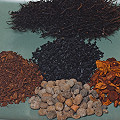Q: About charcoal, bark, and other exotics.

Orchid mixes
A: Some Nepenthes growers have taken a cue from orchid growers by
including charcoal in their soil mixes. Maybe it does something, maybe it
doesn't. Supposedly the charcoal somehow cleans the water by having an "activated" surface or something like
that. Every proponent of charcoal I have met, when pressed about what does that mean exactly, usually trail off their sentences
quietly. Suddenly their scientific explanation sounds more mystical and faith-based than anything else. I wonder why it
should be used, if you use pure water anyway?
My wife and I tried charcoal (more on curiosity than because of good reason) for a few years
with about 30 different plants of a few dozen Nepenthes species and hybrids. We tried a
pumice, charcoal, and Sphagnum mix in a
1:1:1 ratio. After two years, we knocked the plants out of their pots and looked at the root systems.
The Nepenthes hated it---they had stopped growing almost immediately after the repotting,
and we discovered that the roots had refused to explore the new potting material. We repotted the plants into a
Sphagnum and pumice medium, and the plants resumed growth.
I do not intend to use charcoal again, unless I am given compelling reasons!
I am not sure why some people use
various types of bark in their mixes. Is this a tannin-rich kind of aggregate, sort of like a mix between pumice and peat?
I don't know! Or is just that since many Nepenthes growers are also orchid growers,
the orchid bark is just already handy?
That weird black wiry stuff in the background of the "Orchid mixes" photo on this page is osmunda fiber. I've tried this
orchid medium on carnivorous plants, but never with success.
Page citations: Rice, B.A. 2006a; personal observation.